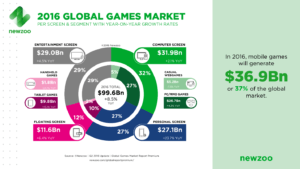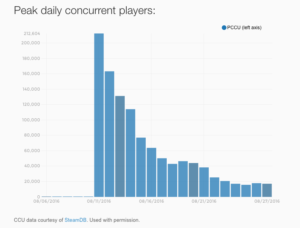Digitization in Video Games: Taking Advantage of Gamers

No Man's Sky release shows the potential pitfalls associated with digitization of game publishing and content distribution.
The $99.6 billion video game industry is currently at an inflection point. 2016 is expected to be the first year that revenue from mobile gaming surpasses that of PC gaming [1]. Companies such as Zynga, King, and Supercell generate billions of dollars making freemium games for tablets and phones. On March 7, 2016, Supercell announced that have reached the 100 million active daily user count [2].
Digitization has undoubtedly been a boon in PC and console gaming as well, not only due to improved graphics and gameplay, but also because of internet-connected services and features. In the past 48 hours, for example, Steam has seen between 12 and 7 million active users online [3]. Microsoft’s Xbox Live has 48 million paid subscribers and Sony’s Playstation Network has 65 million [4][5]. Sony and Microsoft have both publicly stated intent to further grow their online network subscriber base through additional services and support.
Internet connectivity not only allows for gamers to play with or against each other to create a more dynamic gameplay environment, but also provides publishers the opportunity to disseminate patches, updates, and expansions. The ability to instantly provide updates and improvements is an amazing tool for publishers and is something that is starting to move into other industries as software and internet connectivity play bigger roles in devices and equipment. For example, Tesla has significantly improved the performance of its vehicles (and enabled auto-pilot) through software updates [6]. At first, these extra benefits were welcomed by the gaming community, but in recent years publishers have been taking advantage of their ability to push these fixes by releasing software that has been politely described as ‘incomplete’.
Microsoft and Sony’s 2013 console releases were marred by required updates that had to be installed prior to using the brand-new systems. Countless high profile games such as those in the Halo and Grand Theft Auto series have also either required day-one patches or were quite buggy upon release. Grand Theft Auto V’s online gameplay was not only marred by insufficient servers upon release in 2013 but also glitches that made the game unplayable for many gamers. Similarly, games will be released with less content than originally planned (or advertised) so that the publisher may sell future expansion packs.
A prime example of this short-changing is the recent release of No Man’s Sky by independent publisher Hello Games. The game, first officially announced at the E3 conference in 2014, boasted a procedurally generated universe (18.6 quintillion planets!) that players would be able to explore and conquer [7]. Pre-release marketing, including a high-profile demonstration on The Late Show with Stephen Colbert, showed off many features that indicated the game would be revolutionary. Excited, gamers flocked to pre-order the title (which is yet another way that publishers take advantage of gamers) to ensure they could begin playing immediately upon release as well as get the bonus content that comes with pre-orders.
Things began to unravel for Hello Games just over a month before release, when the Reddit page dedicated to the game found leaked information that the release would be pushed back from late June to early August [8]. Players (especially those who preordered) were upset, but willing to wait to ensure the game was as good as it could be. But some on the Reddit page were right when they assumed things weren’t quite what they seemed behind the scenes. Upon the game’s eventual release, players were dismayed that the game lacked many of the features that had been demoed, announced, or hinted at by Hello Games. The Reddit page was suspended due to the vitriolic messages being posted and websites such as onemanslie.com and blog posts titled The difference between No Man’s Sky’s trailers and reality, in one video were created to detail the game’s shortcomings [9][10].
Hello has promised to fix many of the game’s issues and add in some of the features that were expected to be included in the original title, but it may be too late. The below figure shows the rapid decrease in peak concurrent players on Steam, which shows how quickly players were turned off from the product that was initially released [11].
There are several consequences that have come about due to the No Man’s Sky debacle. The United Kingdom Advertising Standards Authority is investigating the promotion of the game, although many in the industry are not confident it will bring about any changes or action against Hello Games [12]. Additionally, The Game Awards 2016 announced that it will focus more on actual in-game footage to promote upcoming games to avoid misleading marketing [13].
Though misleading gamers seems to be a minor consequence of the effects of internet access in gaming, it sheds light on the fact that consumers in other industries can be similarly taken advantage of. (798 words)
Sources:
[1] 2015-2019 Global Games Market Report: Markets, Trends, & Projections. Newzoo. April 21, 2016. http://resources.newzoo.com/global-games-market-report
[2] 100 Million Thank Yous – Youtube. Supercell. March 7, 2016. https://www.youtube.com/watch?v=0sQAj9p_ppU
[3] Steam & Game Stats. Steam. Accessed 17, November, 2016. http://store.steampowered.com/stats/
[4] Microsoft Cloud strength highlights second quarter results. Microsoft. January 28, 2016. http://news.microsoft.com/2016/01/28/microsoft-cloud-strength-highlights-second-quarter-results/#sm.00001g5pnlnq4efe5rvposfun40gg#0CzJSVSor9WDF0zF.97
[5] Consolidated Financial Results for the Fiscal Year Ended March 31, 2015. Sony. http://www.sony.net/SonyInfo/IR/library/fr/14q4_sony.pdf
[6] Support – Software Updates. Tesla. Accessed November 17, 2016. https://www.tesla.com/support/software-updates
[7] No Man’s Sky. Hello Games. Accessed November 17, 2016. http://www.no-mans-sky.com/
[8] No Man’s Sky The Game. Reddit. Accessed November 17, 2016. https://www.reddit.com/r/NoMansSkyTheGame/
[9] One Man’s Lie: Document of an unpleasant deception. Accessed November 17, 2016. http://onemanslie.info/
[10] Kuchera, Ben. The difference between No Man’s Sky’s trailers and reality, in one video. Polygon. August 15, 2016. http://www.polygon.com/2016/8/15/12487406/no-mans-sky-e3-trailer-vs-reality
[11] Kuchera, Ben. No Man’s Sky’s story is being written by its haters. Polygon. http://www.polygon.com/2016/8/29/12691326/no-mans-sky-sony-hello-games-hate
[12] No Man’s Sky investigated over ‘misleading’ adverts. BBC. September 29, 2016. http://www.bbc.co.uk/newsbeat/article/37506501/no-mans-sky-investigated-over-misleading-adverts
[13] Crecente, Brian. The Game Awards will deliver more gameplay, less CGI thanks to No Man’s Sky. November 16, 2016. http://www.polygon.com/2016/11/16/13649776/the-game-awards-2016-no-mans-sky





As a gamer I was delighted to read this post. I vividly remember the original bug-riddled Halo 2 gameplay on Xbox that spurred the developer to release a downloadable software patch shortly after the game came out. My view of the software patch was positive since the original gameplay was sufficiently good to keep me from quitting the game.
When used appropriately, I think software updates can add value to both players and developers. As developers test games before release they are limited by the relatively small samples of gameplay generated by alpha and beta tests. What better way to flush out the last remaining bugs than releasing the game to the public? As long as the game is far enough down the product development funnel the amount of existing bugs should be small and releasing a “good enough” product with the promise of an update can get the game into the hands of players sooner.
I think your example illustrates what happens when developers push the limits of what is acceptable to the consumer. I wonder if there are controls to prevent releases like this from becoming the norm. For instance, is it reasonable to expect that consumers will punish Hello Games in the future by buying fewer copies of their new titles? Additionally, gaming platforms (Xbox, Playstation, etc) employ compliance testing checklists that are supposed to prevent flawed products from reaching consumers.[1] Do you think these checklists can be strengthened to prevent underdeveloped games from being released in the future?
[1] https://en.wikipedia.org/wiki/Game_testing#Methodology
18.6 quintillion planets sure is a lot! This article was very interesting as I had not thought of the potential ramifications of internet access in gaming as it seems to have become such an intertwined part of gaming. Although the bugs seen in earlier releases may be due to developer complacency due to an ability to fix games with patches, I wonder if what happened with No Man’s Sky extends deeper than that. Not including some advertised features has me wondering what the regulation over some of these games are in terms of protecting customers. I am curious to see the results of the United Kingdom Advertising Standards Authority investigation.
Thanks for a great piece. It was really interesting to read about the downsides of internet access in video game production, particularly the capacity to mislead buyers (intentionally or through misguided wishful thinking). Your post as well as Ryan’s comment made me think back to the product development funnel — it seems that continuous internet access may be leading to a more backloaded product development design where there is room for continuous, iterative improvement after release. In that regard, it felt similar to Indigo Agriculture and their model in which launching a product expediently was the emphasis ; they knew that they could iterate and improve better post-launch with the help of input from farmers. Bringing this analogy back to video game production, it seems to me that, when properly marketed and properly executed, video game developers have an incredibly willing fan base that is willing to help ‘beta test’ and aid product improvement. Perhaps billing game releases as a ‘soft launch’ or to a limited set of customers could be an interesting compromise.
Thank you for the supremely interesting topic and well-written article. This is a genre dear to my heart, with No Man’s Sky increasingly emblematic of a growing problem with game releases and marketing: The divergence between expectations (often set by marketing teams) and the reality of a games evolution.
While I truly believe that ongoing patches and updates provided by better software connected games, this has proved a double edged sword – providing studios with more confidence that their games need not be ‘polished’ to the same extend they have in the past – which is dropping consumer confidence in their products in turn. I’m sincerely excited to see how this evolves.
The frustrations gamers have with day one DLC (downloadable content) and unfinished games are real, and the sense that large game companies are nickel-and-diming us out of value is reaching a head. I completely agree with the sentiment that the Internet-based delivery model may be partly to blame. Consumer backlash has been easy to see, with EA winning “worst company in America” for multiple years (though this is likely more to do with the type of person taking Internet polls than a true representation of reality since there are worse things in this world than overpriced video games…)[1].
Part of this is due to the Internet removing the finality from delivering a game. Back in the cartridge / CD era, a game had to be 100% complete before being shipped. Gamebreaking bugs or severe imbalances would either have to be dealt with or require a massive recall (more expensive back then due to materials, packaging, and distribution). As a result, development teams probably put in significantly more effort into final details. Now that that restriction is lifted, developers can just push a game out and then react to player sentiment. Rebalancing retroactively in is now completely normal, a godsend to competitive gamers who can exploit features and play the game in ways developers could never have achieved.
DLC also allows developers to get better data and spend development time more efficiently. In the old model, teams would have to make two full games knowing one might underperform. In the new model, teams can release unfinished” games, then spend time developing DLC for the more-successful games, thus avoiding unproductive development. This model makes a ton of sense, but the sensitivity around pricing is where it gets hairy. Gamers believe they are paying full price for the “unfinished” game plus more for DLC because there is no true reference point for understanding what a game is worth. One could argue that the new model is exactly what is keeping upfront prices down to where they are, or that video game companies are just extracting the margin from saved development time (with games obviously claiming the latter).
If video game companies were more explicit with this model, we could usher in a new era of video game pricing in which games are essentially free for an hour or so, and players can then buy incremental pieces of the game if they want to continue. The uncertainty would be removed – gamers would only buy games they know they liked for as long as they like it. This could potentially improve volume even if pricing would suffer. Gamers who only like multiplayer would not be forced to purchase single-player campaigns, and vice versa. In this world, debacles like No Man’s Sky would be completely avoided since no player would actually end up spending the money, and therefore no studio would see any value in false advertising.
[1] “How Electronic Arts Stopped Being the Worst Company in America.” cNet. [https://www.cnet.com/news/how-electronic-arts-stopped-being-the-worst-company-in-america/]
Very interesting article. My perception is that mobile games/apps are not for serious gamer and I was surprised that sales will surpass those of PC games for the first time this year!
As some of the other commenters have noted, the ability to update games after an initial sale has been made to users means first releases often have not gone through the same rigorous product development process that a physical release necessitates. App developers in particular often release games in “bare bones” states as they hope to refine the game based on customer feedback, and not invest too much up-front in the (likely) event the game completely flops. I saw an interesting article on this topic, related to Pokémon GO which argues that because the developers released a fairly basic game, they have potentially left billions of dollars of revenue on the table (they are still refining and updating the game, adding new features including options for monetization, but the initial world-wide craze that occurred when the game was first released will not be repeated) You can read more about the implications here: http://www.forbes.com/sites/davidthier/2016/09/28/revenue-ran-away-pokemon-gos-lost-billions/#75a50d3c483c
Great topic and great article!
I love how the digital revolution has democratized videogame development through tools (such as unity) or access to finance (through kickstarter or indiegogo). This has lead to much more new indie games eating away the revenues of the big studios and their AAA games. What we see in your article is how Hello games has done something that only AAA were allowed to do before because of their size and renown: release an unfinished game. This is a slippery slope to go down, Hello will probably never be taken seriously and might have damaged the who indie industry by reducing the trust in the system.